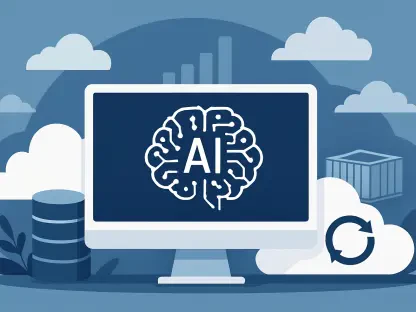The advent of artificial intelligence (AI) is set to revolutionize the European banking sector, enabling institutions to meet increasing customer demands and enhance operational efficiency. AI is increasingly pivotal in their digital transformation strategies as banks strive to innovate and remain competitive.
Empowering Banks with AI
Enhancing Customer Experience
AI’s capacity to process vast datasets instantaneously empowers banks to deliver highly personalized services. Advanced machine learning algorithms scrutinize customer behavior, thereby providing tailored financial products and personalized advice. As a result, customer experience becomes significantly enriched. This ability to customize services is vital in an era where consumers expect more individualized attention and faster, more effective solutions to their financial needs.
With AI-driven insights, banks can anticipate customer needs, foresee potential issues, and suggest the most suitable solutions. These predictive capabilities allow banks to proactively address customer concerns before they escalate. Leveraging AI also helps in managing customer queries and complaints more efficiently, often through intelligent chatbots and automated response systems. Consequently, the interaction between banks and their clients becomes smoother, more responsive, and ultimately fosters greater customer loyalty and satisfaction.
Streamlining Operations
AI-driven automation revolutionizes banking operations by minimizing manual intervention in routine tasks. Robotic process automation (RPA) is employed to handle repetitive tasks such as data entry, transaction processing, and report generation. This automation not only enhances efficiency but also reduces the potential for human error, which can be costly and time-consuming to rectify. By delegating mundane tasks to AI, employees can focus on more strategic and value-added activities, leading to improved overall productivity.
Moreover, AI facilitates smarter decision-making within banks. For example, AI algorithms can analyze vast amounts of financial data, highlighting trends and insights that humans might overlook. This allows employees to make data-driven decisions quickly and accurately. AI’s role in risk management is also noteworthy, as it helps identify and mitigate potential risks through real-time data monitoring and analysis. Implementing AI in banking operations fundamentally transforms the workforce dynamics, engendering a more strategic, efficient, and risk-aware environment.
Ensuring Compliance and Security
Regulatory Compliance
In the backdrop of an increasingly complex regulatory landscape, AI serves as an essential tool for banks to maintain compliance. AI-driven systems continuously monitor transactions, flagging any anomalies that could indicate non-compliance with regulatory standards. This ensures that banks can adhere to evolving regulations without significant delays or additional costs. This real-time monitoring is critical in reducing the risk of penalties associated with non-compliance, safeguarding the institution’s reputation and financial stability.
AI’s role extends beyond transaction monitoring. It aids in the preparation of detailed compliance reports and facilitates transparent auditing processes. These functionalities streamline regulatory adherence processes, making them less cumbersome and more accurate. AI systems also keep pace with changes in regulations, automatically updating compliance protocols as new information becomes available. By adopting AI-driven compliance mechanisms, banks safeguard their operational integrity while efficiently navigating the complexities of financial regulations.
Fraud Detection
Enhancing security is another pivotal area where AI demonstrates significant impact, particularly through its advanced fraud detection capabilities. Machine learning models can identify unusual transaction patterns that signal potential fraudulent activities. By analyzing vast amounts of historical and real-time data, AI can swiftly pinpoint discrepancies and flag suspicious activities for further investigation. This preemptive approach allows banks to respond to fraud risks promptly, thereby minimizing financial losses and protecting customer assets.
Furthermore, AI systems can dynamically adapt to new fraud tactics as they emerge. Traditional security measures often struggle to keep pace with evolving fraudulent strategies, but AI’s learning capabilities enable continuous improvement and refinement of fraud detection algorithms. This ensures that the security measures are always up to date, providing robust protection against increasingly sophisticated fraud schemes. Implementing AI in fraud detection thus offers a proactive defense mechanism, significantly enhancing the security posture of European banks.
Driving Innovation and Growth
New Product Development
AI opens novel avenues for product development within the banking sector. By leveraging AI-driven insights, banks can identify unmet market needs and create innovative financial products that cater to these needs. This agility in product development ensures banks remain competitive, attract new customers, and retain existing ones. AI facilitates the design of products that offer greater convenience, personalization, and value, aligning with modern customer expectations.
Additionally, AI technology enables banks to test new products and services more effectively. Through simulation and predictive modeling, banks can foresee how these products will perform in the real world, thus minimizing risks associated with new launches. This data-driven approach to product development enhances accuracy and efficiency, ensuring that customer requirements and market dynamics are adequately met. Banks using AI for product innovation remain agile and are better positioned to thrive amidst dynamic market conditions.
Expanding Market Reach
AI assists banks in expanding their market reach by providing insights into market trends and consumer behavior. Predictive analytics enables banks to identify potential growth opportunities in new regions, optimizing their expansion strategies. This strategic foresight allows banks to swiftly and effectively tap into underserved markets, driving growth and increasing market share. Understanding local preferences through AI helps banks tailor their offerings to meet specific regional demands, facilitating successful entry and establishment in new territories.
AI-powered market analysis also aids in detecting emerging opportunities and potential threats. By constantly monitoring economic indicators, customer sentiments, and competitive movements, banks can adjust their strategies in real-time to maintain a competitive edge. This proactive approach ensures that banks do not miss out on opportunities and are well-prepared for any market shifts. With AI-driven expansion strategies, banks can enhance their footprint across Europe, fostering growth and stability.
Fostering Collaboration and Integration
Partnerships with Tech Firms
Banks are increasingly collaborating with technology firms to integrate AI solutions seamlessly into their operations. These partnerships with tech firms facilitate the adoption of cutting-edge technology, enhancing banks’ digital capabilities and enabling superior service delivery to customers. By leveraging the expertise of technology firms, banks can accelerate their AI implementation process, benefit from specialized knowledge, and stay ahead in the competitive landscape.
These collaborations also yield valuable insights, as technology firms often bring a fresh perspective to banking challenges. Joint initiatives and innovation projects are common, where banks and tech firms combine their strengths to develop new solutions. This synergy fosters an environment of continuous learning and adaptation, driving mutual growth and ensuring that banks remain on the forefront of technological advancements. Partnerships with tech firms have become an integral part of the AI-driven transformation in European banking.
Integrating Systems
AI facilitates smoother integration of disparate banking systems, ensuring consistency and efficiency across platforms. This seamless integration helps banks deliver a unified experience to customers, enhancing satisfaction and loyalty. By connecting various systems through AI, banks ensure that customer data is accurately shared and utilized, reducing redundancies and improving service delivery. This unified approach underpins robust, efficient banking operations.
Additionally, AI helps overcome the challenges associated with legacy systems by enabling scalable integration solutions. Banks can modernize their infrastructure without significant disruptions, incorporating new technologies that improve overall performance. Advanced AI algorithms assist in maintaining system coherence, ensuring that all components work together smoothly. This holistic integration fosters greater operational efficiency and reliability, underpinning sustainable growth and enhanced customer satisfaction.
The Journey Ahead
Continuous Learning and Adaptation
The journey towards AI-driven transformation is continuous, requiring banks to invest in AI technologies and adapt to emerging developments. Continuous learning and adaptation are crucial to staying ahead in the rapidly evolving financial landscape. Banks must be agile, embracing new AI innovations while refining existing systems to maintain relevance and efficiency. This ongoing investment in AI ensures that banks can respond promptly to market changes and customer demands.
Moreover, fostering a culture of continuous learning within the organization is vital. Employees must be equipped with the necessary skills and knowledge to leverage AI effectively. Training programs, workshops, and knowledge-sharing initiatives can help build an AI-savvy workforce. This commitment to learning and adaptation ensures that banks can fully harness AI’s potential, driving transformative growth and innovation.
Challenges and Opportunities
The rise of artificial intelligence (AI) is poised to transform the European banking sector, allowing institutions to better meet rising customer expectations and enhance their operational efficiency. AI is becoming an essential element in their digital transformation plans as banks aim to innovate and stay competitive in a rapidly evolving market. The integration of AI-driven technologies, such as machine learning, natural language processing, and advanced data analytics, enables banks to offer personalized services, improve risk management, and reduce costs. By leveraging AI, banks can gain deeper insights into customer behavior, streamline complex processes, and strengthen security measures. This technological shift not only aims to improve customer satisfaction but also ensures financial institutions can adapt to regulatory changes and fend off competition from fintech startups. As AI continues to develop, its impact on the banking sector will likely deepen, driving significant changes in how banks operate and serve their customers across Europe.









